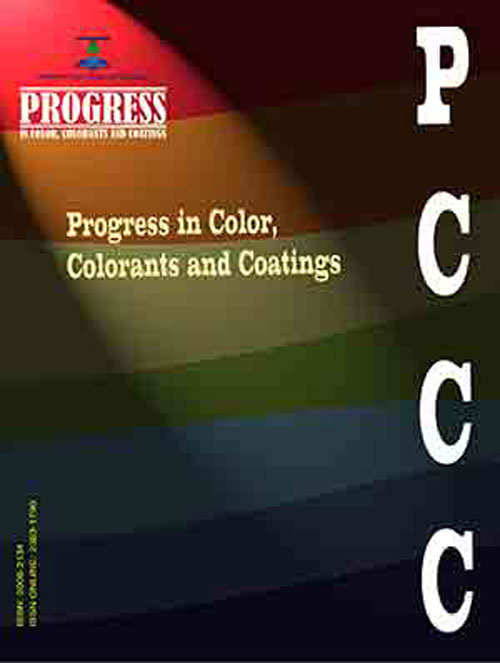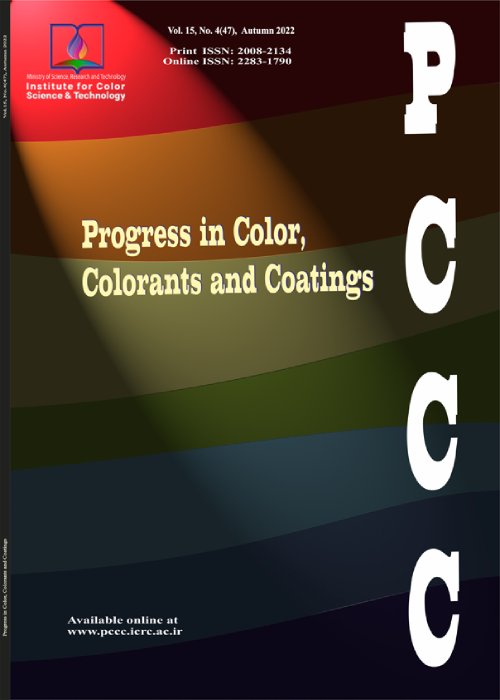فهرست مطالب

Progress in Color, Colorants and Coatings
Volume:14 Issue: 1, Winter 2021
- تاریخ انتشار: 1399/04/29
- تعداد عناوین: 7
-
-
Pages 1-11The corrosion inhibition of API 5L X60 pipeline steel in oil well acidizing fluid stimulated with 1.0 M HCl by Tranexamic Acid (TXA) was investigated using potentiodynamic polarization (PDP), electrochemical impedance spectroscopy (EIS) and the conventional gravimetric or weight loss (WL) techniques at temperatures ranging from 303 to 323 K. Surface morphological analysis was carried out using scanning electron microscopy coupled with energy dispersive X-ray spectroscopy (SEM-EDX). The compound showed high inhibition activity with 98.9% inhibition efficiency at 3.0 g/L concentration of TXA. Polarization analysis indicates that TXA acts as mixed-type inhibitor. The observed decrease in double layer capacitance and an increase in charge transfer resistance obtained from EIS analysis confirmed that TXA performed well as a corrosion inhibitor for X60 steel in 1.0 M HCl medium, ascribed to the adsorption of Tranexamic Acid molecules onto the X60 steel surface. Weight loss analysis showed that inhibition efficiency is increased with the increase of TXA concentration and exposure time while decreased with temperature rise. The adsorption of TXA onto the surface of the X60 steel obeys Langmuir adsorption isotherm. SEM-EDX analysis affirmed the formation of protective adsorbed film of Tranexamic Acid onto the steel surface.Keywords: Inhibition, X60 pipeline steel, Tranexamic acid, Surface morphology, Langmuir adsorption isotherm
-
Pages 13-26he aromatic behavior of the azo-linked cyclopentadienide derivatives have been revealed in various natural compounds. In Tthis research, density functional theory (DFT) calculations at the B3LYP level are used to optimize the geometry of the compounds. In addition, we were interested in the evaluation of the aromaticity of the selected compounds using nucleus independent chemical shifts NICS (0), NICS (0.5), NICS (1), NICS (1.5) and NICS (2), bond lengths and bond angles.Keywords: Cyclopentadienide, DFT, Nucleus independent chemical shift, Aromaticity
-
Pages 27-34
This paper investigates the synthesis of novel Schiff base having 1,2,4-triazole segment and its mixture with low concentrations of polystyrene to make a homogenous matrix. The EDX (energy dispersive X-ray) technique have shown that the major component for both blank and blend polystyrene films is carbon atom. However, it has been demonstrated the appearance of new band related to oxygen, nitrogen, and sulfur for polystyrene/base blend film. This is because of the presence of Schiff base within the polymeric film. The morphological images, after irradiation by UV light, for polystyrene (blank) film proved the formation of cotton-like fibrous material. Micrographs showed the formation of crescent-like material after the irradiation of polystyrene-Schiff base film by UV light for 300 h. This was due to the existence of polystyrene-Schiff base with polystyrene which increased the photo stability of the polymeric film.
Keywords: Polystyrene film, 4-triazole, irradiation, EDX, cotton-like -
Pages 35-45Nowadays, using sustainable dyeing process has become a necessity, but does not meet performance requirements. Application of biomordants was recommended to enhance the quality of dyeing. In order to design a green dyeing process, oak extract as bio-mordants and madder and weld luteola as natural dyes were used. The FTIR-ATR spectra of the washed wool yarn, mordanted wool yarn and mordanted dyed wool yarns confirmed bonding of wool yarns to the green mordant and dyes through a comparing chemical structure. The effective linkage between yarn, mordant and dye molecules removes the C-N peaks in FTIR-ATR spectra. After dyeing process, fastness and colorimetric attributes of dyed wool yarns were investigated. The K/S values of dyed wool yarns with extracted madder and weld luteola was quantified; properties including light, wash, and rubbing fastnesses were defined as per ISO standard methods.Keywords: Bio-mordant, Green Dyeing, Oak, wool, Colorimetric properties
-
Pages 47-54Antisolvent-assisted one-step spin coating approach has been investigated as an effective method for the preparation of perovskite solar cells (PSC) under ambient conditions. The influence of antisolvent dropping delay time on the final morphology was investigated. The photovoltaic device with FTO/TiO2 block/TiO2-mp/CH3NH3PbI3/Au structure was fabricated, and the impact of different delay times on the morphology of CH3NH3PbI3 layers were examined. The hole transport materials (HTM) free PSC with optimal antisolvent dropping delay time exhibited open-circuit voltage (Voc) of 0.76 V with power conversion efficiency (PCE) of 3.54 %, which were much higher than those of the PSC fabricated without antisolvent treatment (Voc of 0.64 V and PCE of 1.51 %). Scanning electron microscopy and X-ray diffraction were used to study the morphology and structure of the CH3NH3PbI3 films. Photocurrent-voltage curves were plotted to investigate the photoelectric properties, carrier transfer, and recombination process in the fabricated perovskite solar cells. Our findings indicated that the proposed antisolvent-assisted one-step spin coating approach can provide a high-performance atmospheric method for fabrication of low-cost HTM-free perovskite solar cells.Keywords: Optimal delay time, Antisolvent, Hole transport materials (HTM), Perovskite solar cell
-
Pages 55-65In this study, for the first time, an electrospun nanofibrous (Nfs) composite was prepared from Zein biopolymer and graphene oxide (Ze-GONfs). The effective parameter in electrospining preparation of zrin-GO nanofiber was the amount of zein. Highly mechanical stable membranes were obtained using 30% w/v in glacial acetic acid. The fiber diameter distribution was in the range of 41–50 nm (zein), 31–40 nm (0.5% GO), 29–39 nm (1.0% GO), and 28–37 nm (1.5% GO). The structural morphology of the nanofibrous composites were characterized using Fourier transform infrared, scanning electron microscope (SEM) and X-ray diffractometer. As an application of the prepared biopolymeric nanofibrous, the removal of malachite green (MG) and methylene blue (MB) (as cationic industrial dyes) from aqueous medium using Ze-GONfs was investigated as a model. The effect of various parameters such as solution pH, adsorbent dosage, dye concentration, time and temperature were evaluated by the Ze-GONfs. Detailed analysis of the adsorption kinetics showed that the adsorption process followed a pseudo-second-order model. The adsorption isotherm was best fitted by the Langmuir model. The thermodynamic results showed that MB and MG adsorption onto the Ze-GONfs was endothermic and spontaneous.Keywords: Electrospinning, Nanofibers Membranes, biopolymer, Adsorption, Kinetic
-
Pages 67-78Glasses with ultra-optical properties are most favored in all-optical communication devices, e.g. switches. Heavy polarizable Bi2O3 and PbO, in their high contents, have achieved the most high index of refraction and dispersion in oxide glasses, particularly in cooperation with relatively heavy glass conditional former, such as, TiO2. In this research, transmission and absorption properties of novel TiO2-Bi2O3-PbO (TBP) glass system were characterized by the spectrophotometry techniques in the near infera-red (2.5-10 µm) and ultraviolet/visible (0.25-1 µm) regions. The corresponding traces were explored with respect to the glass compositions. The Taus plot (method) was executed for the absorption coefficient (attenuation) measurements, and the subsequent related predictions in the uv/visible regions. Results indicated that TBP glasses claimed relatively appreciable absorption around, 7µm due to Ti-O bonds. Addition of TiO2 shifted transmission cut off and the related absorption peaks to higher wavelengths and broadened the absorption region. In the uv/visible region, addition of TiO2, as a conventional glass former, widened the transmission window in all by shifting attenuation to shorter wavelengths, where steeper absorption tails were observed. The overall attenuation in TBP glasses were more affected by Bi2O3 than PbO.Keywords: Attenuation, near infera-red, uv, visible, Spectroscopy, ultra-optical


